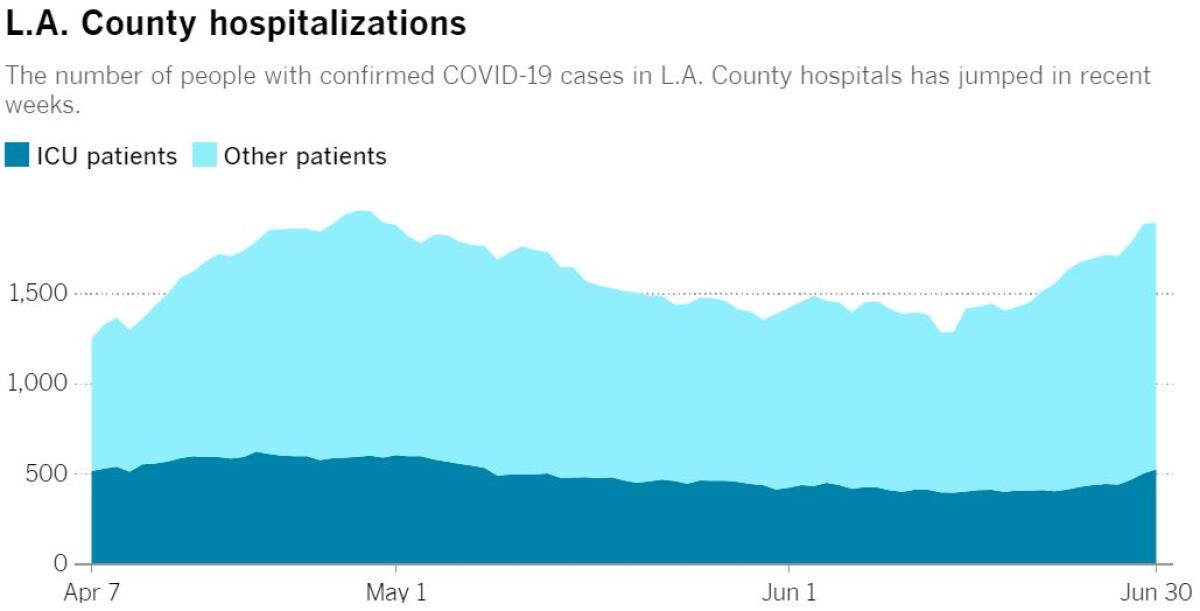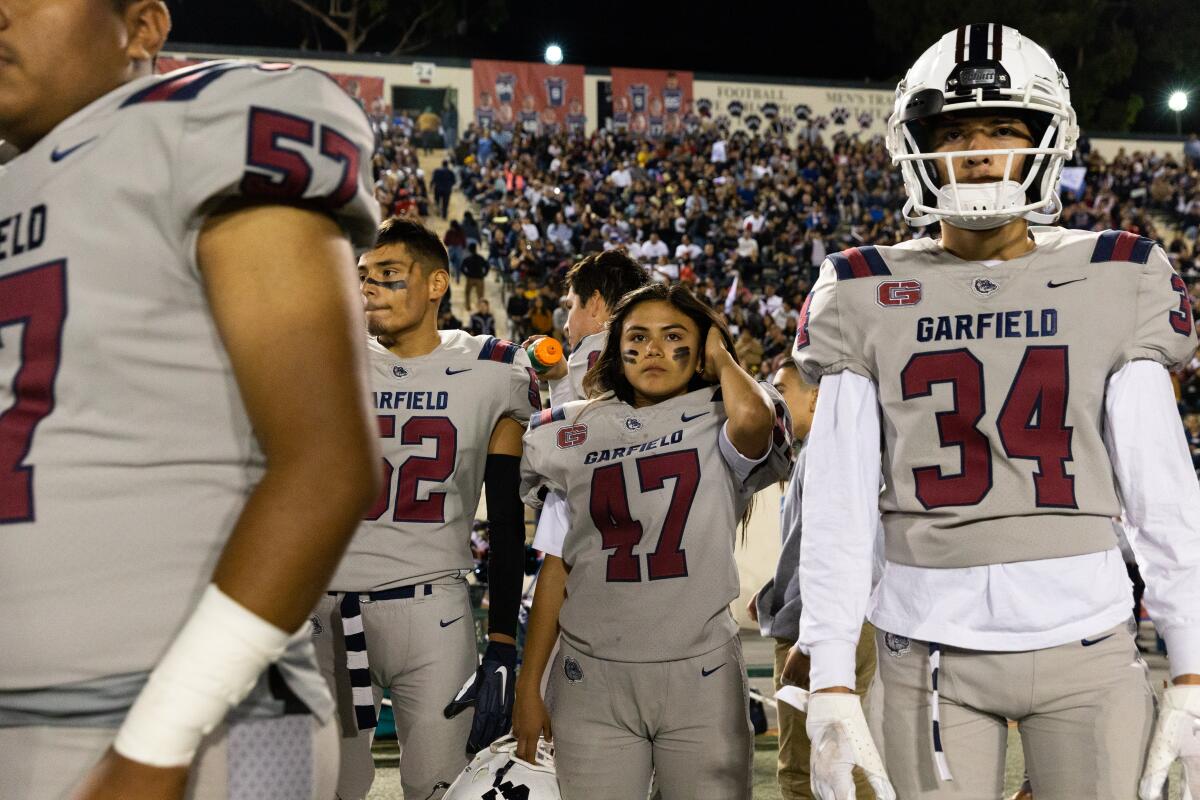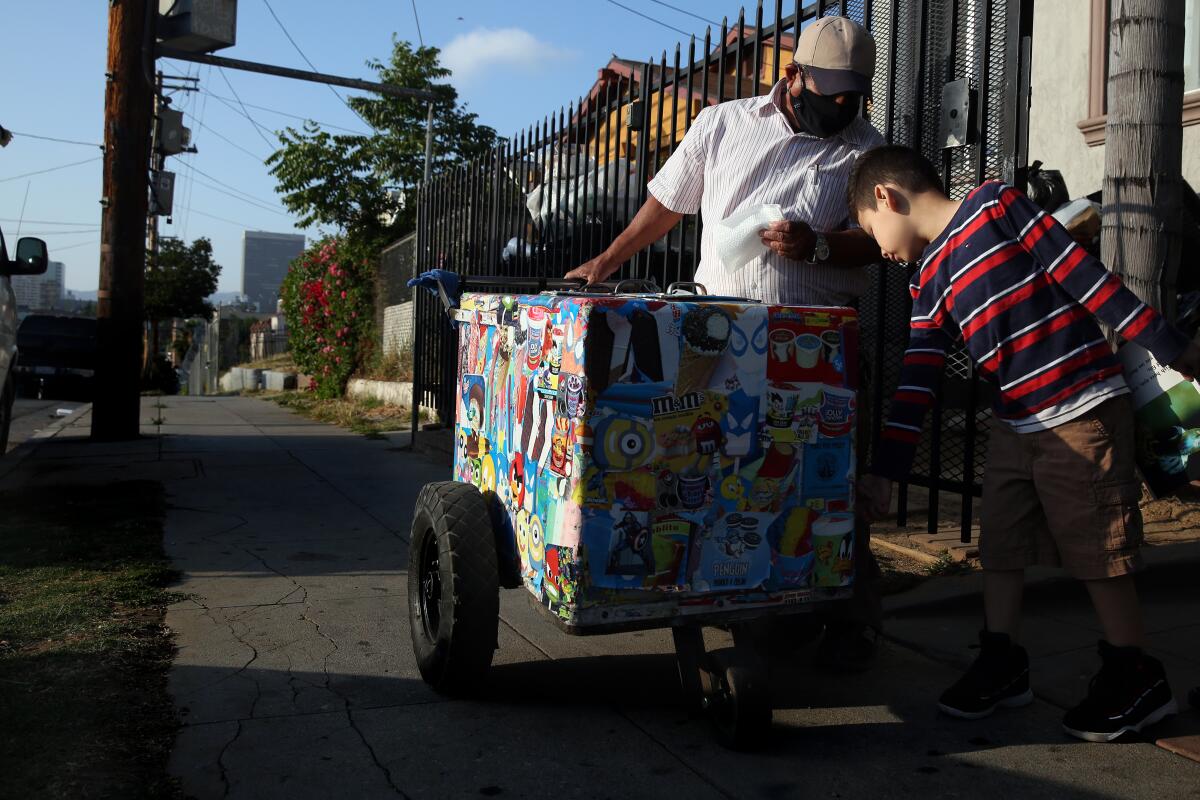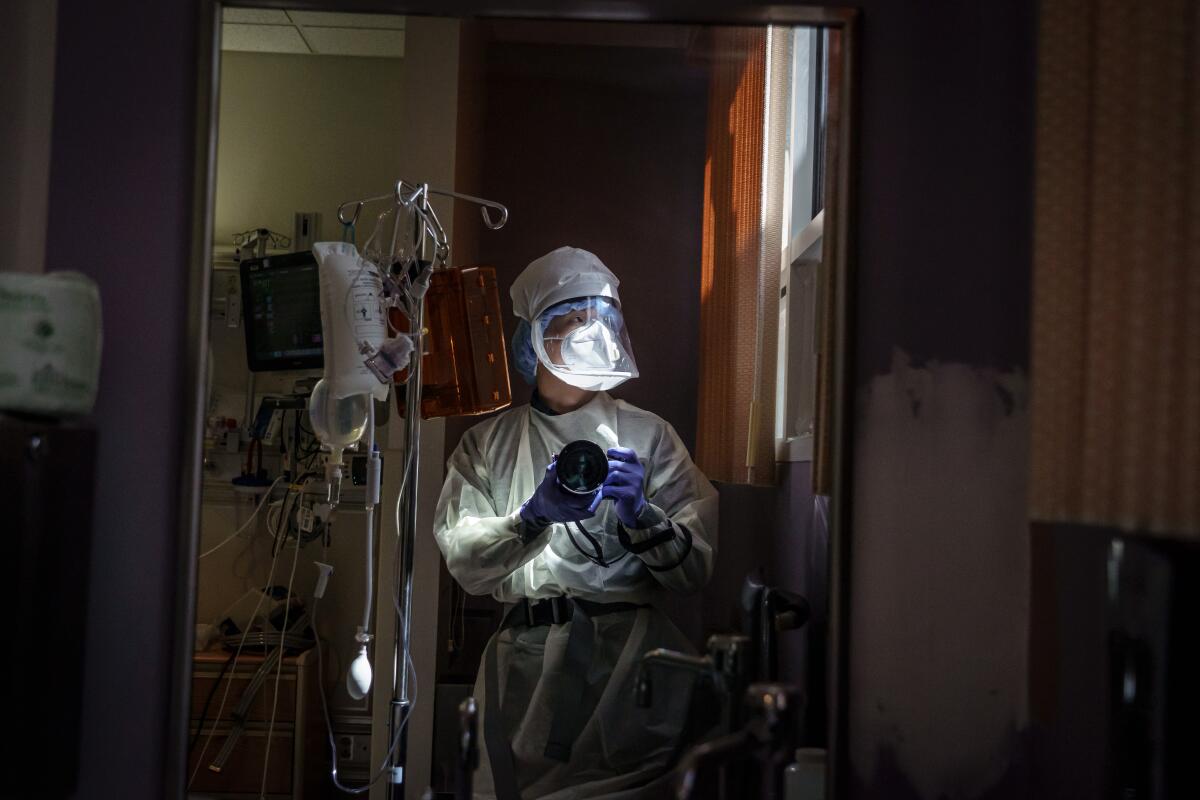Coronavirus Today: Education or enforcement?
Good evening. We’re Diya Chacko and Sam Schulz, and it’s Thursday, July 2. Here’s the latest on what’s happening with the coronavirus, plus ways to spend your weekend and a look at some of the week’s best stories. We’ll be off Friday for the holiday, so the next edition of Coronavirus Today will be in your inbox Monday. (The Health and Science digest newsletter is also taking this weekend off.)
Don’t expect to spend any of the long weekend on a Southern California beach. As coronavirus cases continue to surge, officials across the region have opted to close the vast majority of beaches this weekend over fears that holiday crowds could make an already critical outbreak even worse. Los Angeles and Ventura counties have closed theirs, and in Orange County, a dozen county-run beaches and a handful of city ones will be closed.
The closures reflect alarming growth in California’s coronavirus spread, as well as growing fears among public health officials that social gatherings over the holiday weekend could bring even more outbreaks. Cases have surged, prompting officials to order indoor dining shut down in much of the state, and the number of people hospitalized has jumped 56% in two weeks, a sign of the intense pressure COVID-19 is putting on the state’s medical infrastructure.
L.A. County has not eclipsed its highest daily total of confirmed COVID-19 hospitalizations, which crested April 28, but it’s getting close. “L.A. County’s really at a critical juncture in the pandemic,” said public health chief Barbara Ferrer.

In response, Los Angeles has unveiled a new color-coded system to assess and report the risk of infection. (Today, L.A.’s indicator was orange, meaning that the risk of infection remains very high.) USC has dropped a plan to welcome students back to campus in the fall. And West Hollywood has promised to fine people who violate the statewide mask mandate, to the tune of $300 — a rare move toward a policy of enforcement, not just education.
In red states, some Republican public officials’ efforts to educate and to enforce have been complicated and undermined by President Trump. Many GOP politicians followed his lead in the early months of the crisis by embracing a swift reopening of their economies. Now they’re trying to curb the contagion — but they’ve had trouble doing so without contradicting Trump, who won’t wear a mask in public and broadly downplays the threat.
The president appears to be in denial as the country racks up record numbers of confirmed cases daily. He described the coronavirus Thursday as more of a nuisance than a crisis, choosing instead to cheerlead a nascent economic reopening that public health experts believe is contributing to the rising caseload. Although Trump blames that rise on increased testing, a larger share of tests is coming back positive than before, a sign that more people are growing sick. His sanguine attitude is at odds with the public’s: A growing majority of Americans says the situation is getting worse, a new survey found.
By the numbers
California cases and deaths as of 3:59 p.m. PDT Thursday:

Track the latest numbers and how they break down in California with our graphics.
What to read this weekend
Going to the dentist during the pandemic isn’t as bad as you might think. When a toothache forced him to go, a Times senior features writer found that despite some procedural differences — and a whole lot of safety signage on display — the experience wasn’t all that different than it had been before. Let his pain be your gain.
It’s déjà vu for AIDS activists. A Republican president dismissing a disease. His administration ignoring early warning signs. Death rates soaring, with no end in sight. These feel all too familiar to the AIDS activists of the ’80s and ’90s, who fear the fight against COVID-19 will be an equally rigorous policy battle, with worse damage.
Playing five sports helped her cope — until the quarantine. Here’s how Dalia Hurtado copes with having family in two places: She’s on her high school varsity football, volleyball and soccer teams and participates in soccer, softball and boxing through neighborhood and club programs. In the last few months, her life has been made even more complicated by a deadly virus that has taken away the two things — schools and sports — that have kept her focused.

Who doesn’t trust Lucy Jones in a crisis? For more than three decades, the famed seismologist has kept Southern California grounded whenever the earth has shaken and has drilled into us one key earthquake response: “Drop! Cover! Hold on!” When it comes to coronavirus messaging, she has a similarly clear message: “Don’t share your air.”
“What’s my next move?” Even in a thriving economy, people with arrest records often struggle to find work. During the pandemic, their prospects have only gotten worse.
A UCLA Health end-of-life program has been repurposed to meet the demands of the coronavirus crisis. The 3 Wishes project aims to make the end of life more dignified and personalized by fulfilling small requests for dying patients and their families in the ICU.
Being a paletero is hard enough in normal times. But during the pandemic, with parks and schools closed and people afraid to leave home, much of the usual clientele has vanished for ice cream vendors like Mauro Rios Parra. Instead he decamps to Pico-Union’s crowded apartment buildings, where the jingle of his cart’s bells draws people young and old hungry for tamarind pops and Choco Tacos. He loves his work, but soon he plans to reunite with his family in Oaxaca.

Your support helps us deliver the news that matters most.
What to do this weekend
Get outdoors. Here’s the latest on what’s open and what’s closed, beyond just beaches, from Christopher Reynolds and Mary Forgione. You can sign up for her newsletter the Wild for more.
Get grilling. Fire up the barbecue for the Fourth of July with these restaurant grilling kits. If you want a more DIY kind of picnic, our cooking columnist Ben Mims recommends shareable sub sandwiches, plus pies you can eat like a pizza, and if you want a vegan alternative, cooking editor Genevieve Ko suggests jackfruit carnitas tacos. Get more from their weekly Cooking newsletter.
Protect your pet. For our pets, fireworks on the Fourth of July can be stressful and traumatic. Experts say preparation is key and offer some tips to minimize the stress.
Listen to a podcast. Try “Coronavirus in California” for dispatches from the front lines. For stories from beyond from the crisis, check out our podcast “It Was Simple: The Betty Broderick Murders,” written and hosted by columnist Patt Morrison. Here are more great podcasts, too.
Resources
— For general safety, wash your hands for at least 20 seconds (here’s a super-fun how-to video). Stop touching your face, and keep your phone clean. Practice social distancing, maintaining a six-foot radius of personal space in public. And wear a mask if you leave home. Here’s how to do it right.
— Watch for symptoms including fever, cough, shortness of breath, chills, repeated shaking with chills, muscle pain, headache, sore throat and loss of taste or smell. If you’re worried you might be infected, call your doctor or urgent care clinic before going there.
— Need a COVID-19 test? Here’s how to receive a free test if you’re in L.A. County. And here’s a map of testing sites across California.
— Here’s how to care for someone with COVID-19, from monitoring their symptoms to preventing the virus’ spread.
— If your job has been affected by the pandemic, here’s how to file for unemployment.
— Here are some free resources for restaurant workers and entertainment industry professionals having trouble making ends meet.
— Advice for helping kids navigate pandemic life includes being honest about uncertainties, acknowledging their feelings and sticking to a routine. Here’s guidance from the CDC.
— In need of mental health services? Here are resources for coping during the crisis from the CDC and the L.A. County Department of Public Health. L.A. County residents can also call (800) 854-7771 or text “LA” to 741741.
— Tempted to go out now that the economy is reopening? Here’s how you can assess your risk.A pandemic in pictures

“When I first saw myself in the mirror, I thought it was someone else looking through a window into the negative pressure isolation room I was in,” Times photographer Marcus Yam says of his experience documenting the Scripps Mercy Hospital Chula Vista intensive care unit as it cared for a COVID-19 patient. “I did not recognize myself in the personal protective equipment and full-face powered air-purifying respirator I was wearing.” Here are more self-portraits and stories from the Times photojournalists covering the pandemic.
Got a question? Our reporters covering the coronavirus outbreak want to hear from you. Email us your questions, and we’ll do our best to answer them. You can find more answers in our Frequently Asked Questions roundup and in our reopening tracker.
For the most up-to-date coronavirus coverage from The Times over the weekend, visit our homepage and our Health section, listen to our “Coronavirus in California” podcast, sign up for our breaking news alerts, and follow us on Twitter and on Instagram.





